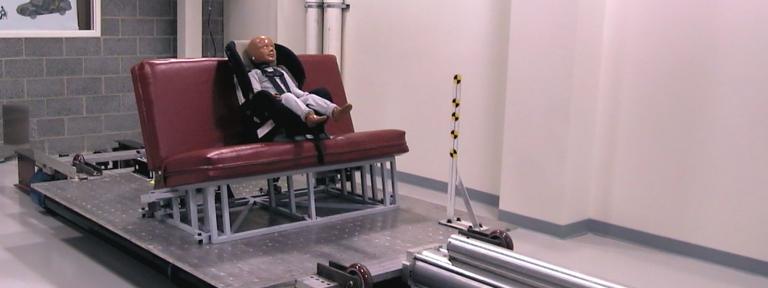
“It is gratifying to hear from students that this course is relevant to their careers.”
Just how much can one college class prepare you for your career? Actually, quite a lot according to Mary DiDonato and Robert McKee, who both found the MECH 550 Injury Criteria class they took from Dr. Patrick Atkinson to be quite useful in their careers.
Mary DiDonato ’11, a test engineer in the Survivability Armor Ballistics Lab at the U.S. Army TARDEC facility in Warren, Mich., found the MECH 550 class coursework gave her an edge on the job. She is currently working on a program to assess injury criteria in order to develop new test specifications for TARDEC.DiDonato said she found the MECH 550 class interesting but “never realized how much it would help my career.” She has been asked to help with two projects outside her primary responsibilities at TARDEC due to her experience in the class.
Robert McKee, who will graduate with a degree in Mechanical Engineering-Biomechanical concentration in September, recently had a job interview with an orthopedics firm that was impressed he had done simulated surgeries in an undergraduate class. “My experience with laparoscopy and stitching the hot dog inside the box with a camera was useful since that company is doing a lot of things with minimally invasive surgeries right now,” said McKee.McKee, of Holt, Mich., has also found that his experience in the Occupant Safety class and an understanding of federal motor vehicle safety standards are helpful when applying for jobs in the auto industry.
“It is gratifying to hear from students that this course is relevant to their careers,” said Dr. Patrick Atkinson, professor of Mechanical Engineering, who is always looking for ways to improve course materials to keep pace with changes in industry in his MECH 550 class (officially known as Automotive Bioengineering-Occupant Protection and Safety).
“MECH 550 is important to me,” said Atkinson. “I realized in 2000 that it was a necessary addition to the Kettering curriculum. At that time, and possibly today, there was no other school offering such a course to undergrads,” he added.
To increase the relevance of the MECH 550 class curriculum, Atkinson is currently utilizing a relatively straightforward computer program called “Working Model” that requires students to write software that predicts potential injuries during crash events.In this virtual crash testing, students use the software to build a virtual crash test dummy and perform virtual crash testing. “When they start in my class,” Atkinson said, “the computer screen is blank. They have to develop every part of the dummy before putting it through crash events.” The software also enables them to “tweak the airbag, seat belt and other safety features to change the dynamics of the crash event and possible resultant injuries.
“In industry, a similar software program is much more complicated and takes users a year or more to become adept enough at using it to become proficient,” he said. “Kettering’s approach with a simpler software enables student to achieve results in the span of an academic term.” Utilizing the "Working Model" software allows efficient use of Kettering’s physical Crash Safety Center where ‘real’, not virtual, crashes happen. “I can start by having the whole class conducting crash simulations at once with the software,” said Atkinson. When students achieve what they think is the best case scenario in the virtual world they can “check” their hypothesis in three dimensions in the Kettering Crash Safety Center using the crash sled “where the laws of Physics rule,” Atkinson joked.
“With the simulations you can control all the conditions at the click of a button such as the seat belt strength or the precise speed at which the crash happens; in the real world you can’t control all the conditions and there is variability all over the place -- it's real-world and a little messy compared to the mathematical-virtual side of things,” he explained. Currently Kettering University is the only university to use a crash sled in undergraduate crash safety courses.
During the Spring 2012 term there was an added bonus because Atkinson was co-teaching a community Child Safety Seat Checker course offered at Kettering University in conjunction with Keep Kids Safe and Hurley Medical Center, while also teaching MECH 550. Students taking their virtual projects from the classroom to the Crash Lab got a hands-on tutorial out-of-doors en route to the lab when Atkinson detoured them through the Child Safety Seat Checker class. Students from the training course and the MECH 550 class co-mingled as Atkinson and Lew Moquin, of Hurley, lectured briefly on how to use physics in the design of a car seat to keep children safe throughout a crash event.
Both groups learned that the two major concerns for car seat manufacturers are the crash event itself and the rebound of the child in the seat immediately following the crash. Current research being done at Kettering University includes side impact crash testing on car seats. With no governmental standards currently in place for car seats in side impact crash events, according to Moquin, manufacturers are establishing their own standards with the help of research facilities such as Kettering’s Crash Safety Center.
For students in the Spring 2012 MECH 550 class this means they learned about future industry standards before they were implemented. They don’t know it yet, but this knowledge could translate into job opportunities later.